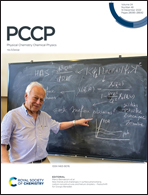Electrochemical behaviors of Li–B alloys in a LiCl–LiBr–KBr molten salt system
Abstract
Li–B alloys present higher voltages and better power performances than those of conventional Li–Al and Li–Si anodes for thermal batteries. Herein, the electrochemical characteristics of the Li–B alloy in the LiCl–LiBr–KBr electrolyte, including the discharge mechanism, charge transfer coefficient and exchange current density, were investigated in the temperature range of 623–823 K by open circuit potential (OCP), cyclic voltammetry (CV), chronopotentiometry (CP), linear sweep voltammetry (LSV) and electrochemical impedance spectroscopy (EIS) techniques. Consequently, the OCP of the Li–B alloy in the LiCl–LiBr–KBr electrolyte is close to that of pure lithium at the investigated temperatures. The discharge of the Li–B alloy electrode includes electrochemical dissolution of free lithium (Li → Li+) and compounded lithium (LiB → Li+ + B). The charge transfer coefficient in the anodic direction (Li → Li+) is about 0.63 at 623 K, which slightly increases as the temperature increases. The exchange current density of the Li (Li–B)/Li+ couple determined by the EIS method increases from 3.84 A cm−2 to 8.40 A cm−2 when the temperature increases from 623 to 823 K, corresponding to an activation energy of 16.4 kJ mol−1. These results suggest that the Li–B anode allows ultrahigh-rate discharge in thermal batteries.

- This article is part of the themed collection: 2022 PCCP HOT Articles


 Please wait while we load your content...
Please wait while we load your content...